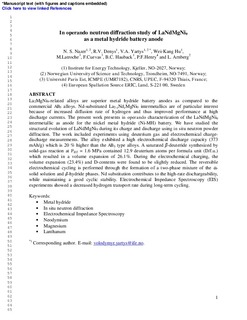| dc.contributor.author | Nazer, N.S. | |
| dc.contributor.author | Denys, Roman Volodymyrovich | |
| dc.contributor.author | Yartys, Volodymyr | |
| dc.contributor.author | Hu, Weikang | |
| dc.contributor.author | Latroche, M. | |
| dc.contributor.author | Cuevas, F | |
| dc.contributor.author | Hauback, Bjørn | |
| dc.contributor.author | Henry, P.F. | |
| dc.contributor.author | Arnberg, Lars | |
| dc.date.accessioned | 2017-03-30T07:01:35Z | |
| dc.date.available | 2017-03-30T07:01:35Z | |
| dc.date.created | 2017-03-28T10:18:06Z | |
| dc.date.issued | 2017-03-01 | |
| dc.identifier.citation | Journal of Power Sources. 2017, 343 502-512. | nb_NO |
| dc.identifier.issn | 0378-7753 | |
| dc.identifier.uri | http://hdl.handle.net/11250/2436278 | |
| dc.description.abstract | La2MgNi9-related alloys are superior metal hydride battery anodes as compared to the commercial AB5 alloys. Nd-substituted La2-yNdyMgNi9 intermetallics are of particular interest because of increased diffusion rate of hydrogen and thus improved performance at high discharge currents. The present work presents in operando characterization of the LaNdMgNi9 intermetallic as anode for the nickel metal hydride (Ni-MH) battery. We have studied the structural evolution of LaNdMgNi9 during its charge and discharge using in situ neutron powder diffraction. The work included experiments using deuterium gas and electrochemical charge-discharge measurements. The alloy exhibited a high electrochemical discharge capacity (373 mAh/g) which is 20% higher than the AB5 type alloys. A saturated β-deuteride synthesized by solid-gas reaction at PD2 = 1.6 MPa contained 12.9 deuterium atoms per formula unit (D/f.u.) which resulted in a volume expansion of 26.1%. During the electrochemical charging, the volume expansion (23.4%) and D-contents were found to be slightly reduced. The reversible electrochemical cycling is performed through the formation of a two-phase mixture of the α-solid solution and β-hydride phases. Nd substitution contributes to the high-rate dischargeability, while maintaining a good cyclic stability. Electrochemical Impedance Spectroscopy (EIS) was used to characterize the anode electrode on cycling. A mathematical model for the impedance response of a porous electrode was utilized. The EIS showed a decreased hydrogen transport rate during the long-term cycling, which indicated a corresponding slowing down of the electrochemical processes at the surface of the metal hydride anode. | nb_NO |
| dc.language.iso | eng | nb_NO |
| dc.publisher | Elsevier | nb_NO |
| dc.rights | Attribution-NonCommercial-NoDerivatives 4.0 Internasjonal | * |
| dc.rights.uri | http://creativecommons.org/licenses/by-nc-nd/4.0/deed.no | * |
| dc.title | In operando neutron diffraction study of LaNdMgNi9H13 as a metal hydride battery anode | nb_NO |
| dc.type | Journal article | nb_NO |
| dc.type | Peer reviewed | nb_NO |
| dc.source.pagenumber | 502-512 | nb_NO |
| dc.source.volume | 343 | nb_NO |
| dc.source.journal | Journal of Power Sources | nb_NO |
| dc.identifier.doi | 10.1016/j.jpowsour.2017.01.077 | |
| dc.identifier.cristin | 1461603 | |
| dc.relation.project | Norges forskningsråd: 234246 | nb_NO |
| dc.description.localcode | ©2017 Elsevier B.V. All rights reserved. This is the authors' accepted and refereed manuscript to the article. Locked until 1 March 2019 due to copyright restrictions | nb_NO |
| cristin.unitcode | 194,66,35,0 | |
| cristin.unitname | Institutt for materialteknologi | |
| cristin.ispublished | true | |
| cristin.fulltext | postprint | |
| cristin.qualitycode | 1 | |

